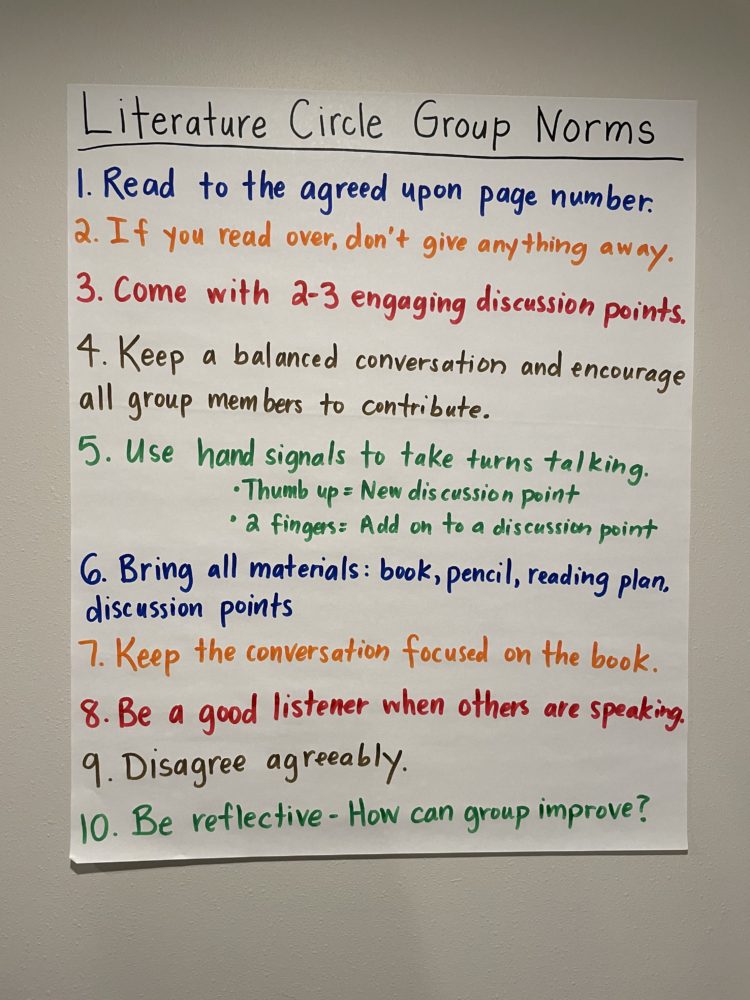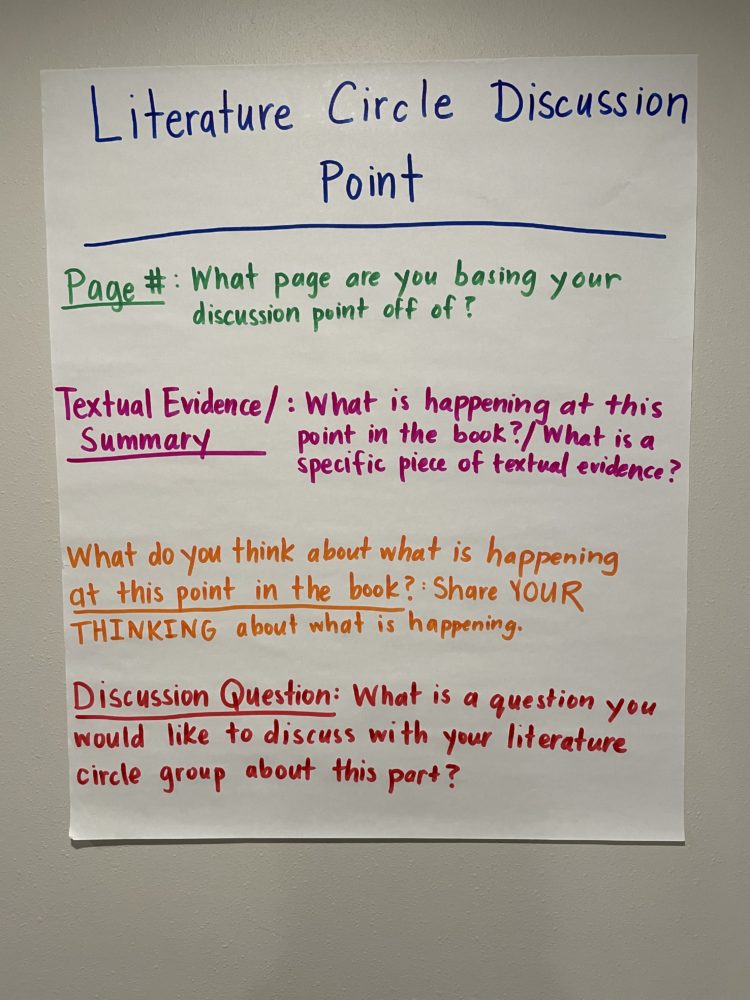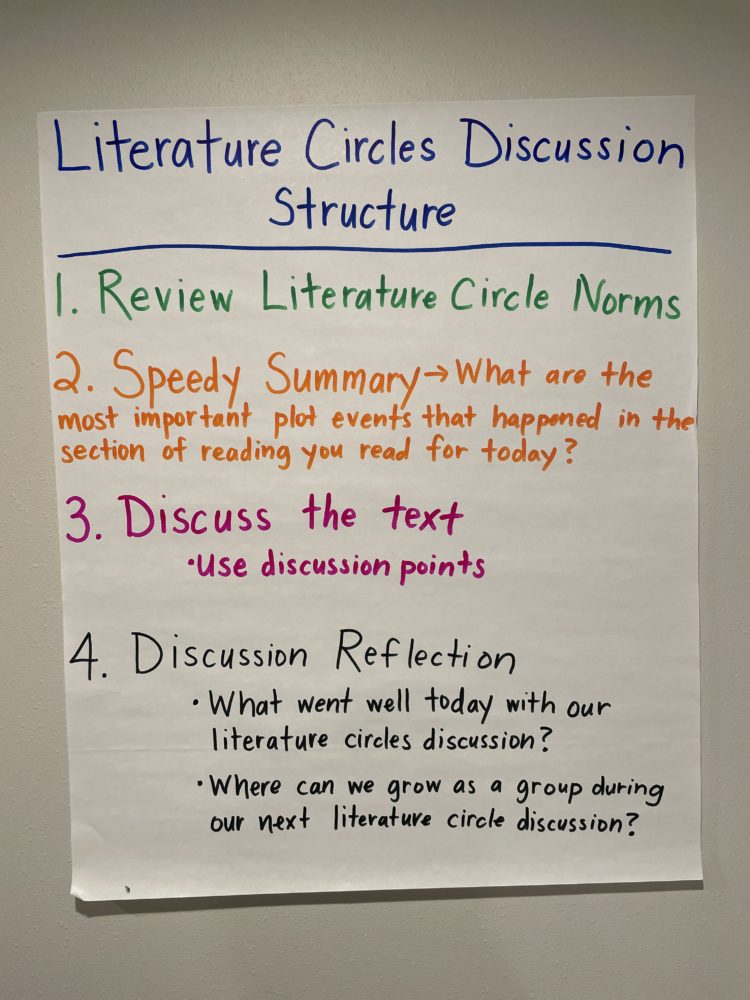You have made the decision to try out literature circles in your middle school ELA classroom. That’s awesome! Rather than handing students a book and diving in, I recommend strategically getting literature circles started through a series of steps. These steps help get the process of literature circles organized for teacher sanity and familiarizes students with discussion norms and what to expect when their literature circle group meets.
Before going over the steps to implementing literature circles in your classroom, I want to give my definition of what literature circles are. Literature circles are when a class of students is given a choice of 4-5 book titles that all share a common thread (theme, genre, author, etc.). The teacher gives a book talk for each book and allows students to express their top reading choices. The teacher then puts heterogeneous groups of students together by book interest. This differs from guided reading where a teacher would form groups homogeneously to match students reading levels. Once in a group, students form a reading plan and group discussion norms. The teacher then meets with one group per day each week for approximately 4 weeks. During the literature circle discussion, the teacher takes on more of an observer role, and the discussion is student-led and fueled based on the discussion materials students prepared while reading.
Logistically, literature circle group meetings last 15-20 minutes, and there are 4-6 students in each group.
Follow the steps below to get literature circles going in your classroom:
-Select a book set of 4-5 books that share a common thread. If you use reading units, select book titles that all complement the theme, genre, author, or topic your unit is based off of.
-Give a 2-3 minute book talk on each of the book choices. In addition, you could get students in small groups and give them one copy of each literature circle book choice. Students can then get 1-2 minutes to scan and examine each book choice.
-Now that students have learned about their book options, have them fill out a sheet to indicate their top preferences of which book they want to read.
-Next, set the groups by trying to give students one of their top three choices while doing your best to balance the groups. Remember, these groups should not be based on ability level, each group should contain students with a variety of reading levels (heterogenous groupings).
-Once you’ve established literature circle groups, make a literature circles calendar to create a reading schedule for each group with meeting dates and page numbers they should read for each meeting date. This schedule will allow you to meet with every group one time per week.
-Pick a date for every group’s initial meeting. All groups can meet on the same day for their initial meeting. At this time, distribute the literature circles calendar and have students create norms they would like all members of their group to follow. I recommend making an anchor chart with group norms for literature circles to hang near your small group meeting area for quick and easy reference. See the example anchor chart with group norms for literature circles below. If time allows, have students begin reading the book together, encouraging them to stop and discuss the beginning of the book as needed.

-Have student volunteers fishbowl a literature circle discussion with a short story that you read aloud to students prior to literature circle groups meeting for the first time. As the small group of student volunteers models a literature circle discussion for the class, have the rest of the class circle around them and observe. Have students on the outside of the fishbowl jot down observations about what they notice, see, and hear. Come together as a class and discuss the conversation that was observed to help reiterate norms and expectations for an in-depth, enjoyable discussion.
-Decide what type of preparation you would like students to do for literature circle discussions. I highly recommend having students bring 2-3 discussion points to each literature circle group meeting. It’s important to model high quality discussion points (use interactive read aloud to model a discussion point you would use to discuss the read aloud) and give students a format for writing discussion points. The anchor chart below gives an example of what this format could look like.

-During the first week of literature circles, students are reading and preparing. Do quick check-ins with groups to make sure students are understanding the beginning of their book and completing the necessary preparation to drive their own group discussion. When the second week begins, follow the meeting calendar and meet with one group each day. Remember, in literature circles, the teacher’s role is an observer. Take the time to sit back and really listen and notice what your students’ strengths and weaknesses are. You may also choose to use a literature circles discussion rubric to evaluate students’ contributions to their group’s discussion or have students complete a self and peer evaluation to capture how they think the discussion went.
-Follow a common literature circles structure each time a group meets. Check out an example structure from the anchor chart below. Ensure that students are using the agreed upon discussion norms when their group is meeting. One key discussion norm is to establish how students will know when to talk. I recommend having students use hand signals. An example of what my students do is if they have a new discussion point to bring up, they put their thumb on the table. If they would like to add onto something another classmate said, students press two fingers together and put them on the table. We always allow the students who want to add on to a current discussion point speak before moving on to a brand-new discussion point. I encourage students to dig deep into worthy discussion points rather than firing off new discussion point after new discussion point.

Students amaze me during literature circles every single time. I always fear that my voice and my opinions become too loud in the ELA classroom, and this is truly a time for students’ voices and opinions to shine. Students will always share something about the book that I never even considered. For all these reasons and many more, I highly recommend taking the steps above to implement literature circles in your middle school classroom. If you’re wanting more guidance, I do have a step-by-step resource with everything you need to fully implement literature circles in your middle school classroom. You can access it by clicking here. Additionally, all of my reading units contain literature circle resources made specifically for the genre of the reading unit. To check out my realistic fiction reading unit, click here.
Kasey





